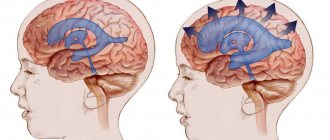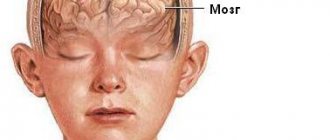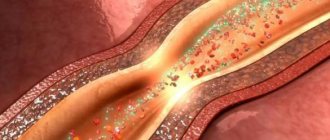Medical certificate
The main components of the brain are 4 ventricles. They are represented by small cavities. They constantly produce and circulate cerebrospinal fluid. Its main purpose is to transport nutrients to cells and remove waste products. In addition, cerebrospinal fluid plays a kind of shock-absorbing role during head impacts.
Normally, each ventricle contains about 150 ml of cerebrospinal fluid. It is completely updated three times a day. An increase in its volume provokes an increase in the size of the ventricles and a change in their shape. When the lateral C-shaped curvature disappears, the cavity becomes rounded. In this case, they speak of the initial stage of lateroventriculoasymmetry of the brain.
What it is? Such a terrible diagnosis refers to a disorder characterized by an asymmetric change in the size of the ventricles. To a small extent, such changes are not considered a pathology. However, their noticeable progression can lead to severe brain disorders. Enlarged ventricles begin to put pressure on surrounding elements and structures, causing disruption of the functioning of neurons. In some cases, death of nerve cells is observed.
Reasons for the development of the anomaly
The pathology can either be congenital or be the result of other health problems. In infants, lateroventriculoasymmetry is more common than in adults. Approximately every 500th newborn is diagnosed with an increase in the size of the ventricles, and in 80% of cases it is caused by congenital abnormalities in brain development. The remaining 20% are due to birth injuries. A child may develop intrauterine anomalies due to problems with the woman’s health during pregnancy. We are talking about such diseases as toxoplasmosis, rubella and mumps.
The causes of lateroventriculoasymmetry of the brain in adults are somewhat different. An increase in cerebrospinal fluid and, as a consequence, the size of the ventricles can be provoked by:
- skull injuries;
- previous neuroinfections (for example, meningitis);
- tumors, cysts, hemangiomas;
- thrombosis of cerebral vessels.
Accurate determination of the cause of the outflow disturbance and excessive production of cerebrospinal fluid allows you to prescribe effective treatment.
The course of fetal ventriculomegaly in pregnant women after 35 years
Ventriculomegaly in the fetus most often develops if the child’s mother is over 35 years old. This happens for the following reasons:
- The risk of genetic disorders (for example, Down syndrome) increases;
- Intrauterine infections occur more often;
- A pregnant woman over 35 years of age is susceptible to complications while bearing a child.
Thus, if the mother is under 35 years old, ventriculomegaly in the child occurs only in exceptional cases.
Clinical picture
Moderate lateroventriculoasymmetry of the brain does not affect the human condition. We can talk about the development of a pathological process in the presence of pronounced changes in the lateral ventricles. In this case, the patient feels the symptoms of the primary disease, which provoked lateroventriculoasymmetry. This may involve problems with sensation, memory, coordination or thinking. Typically the patient complains of:
- pain in the head, a feeling of squeezing and bursting;
- nausea and vomiting, especially in the morning;
- dizziness;
- state of anxiety.
The patient is constantly accompanied by apathy and drowsiness. Such symptoms of lateroventriculoasymmetry of the brain indicate that the pathology is progressing. As a result of impaired outflow of cerebrospinal fluid, pressure on the brain increases, which leads to:
- oculomotor disorders;
- development of dementia;
- blurred vision;
- urinary incontinence;
- impaired motor function (gait becomes unsteady).
If treatment for the anomaly is not started in a timely manner, it can become chronic.
Symptoms and signs
Ventricular asymmetry does not have a specific clinical picture. All symptoms of the pathology are common and are characteristic of many infectious diseases of the nervous system. In terms of symptoms, asymmetry can imitate, for example, intoxication syndrome.
Symptoms of pathology in adults:
- Dizziness and headaches.
- Nausea and urge to vomit.
- Feeling of fullness in the head.
- Fast fatiguability.
- Visual impairment, slower reaction of the eyes to a visual stimulus.
- Diplopia is double vision.
- Hearing impairment, possibly tinnitus.
- Unpleasant sensations in the head when turning the head sharply, sneezing and coughing.
- Mental symptoms: irritability, emotional lability.
- Autonomic symptoms: hyperhidrosis - increased sweating, hot flashes to the extremities.
It is important to remember that the presence of these symptoms does not determine that the lateral ventricles of the brain are asymmetrical and the final diagnosis is made only after instrumental research methods.
Signs of pathology in children:
- Constant crying, anxiety.
- Lack of appetite.
- Throwing the head back.
- Frequent regurgitation immediately after eating, as a result of which the child does not gain weight well.
Course of the disease in children
The manifestation of the pathological process in young patients depends on age. Children are usually capricious and do not eat well. Their gaze is directed downward, but their eyes are excessively open. In children, the bones of the skull are flexible and plastic. Therefore, disorders can manifest themselves in an increase in head size. Pulsation of the fontanel and swelling of the veins are often observed.
School-age children also suffer from lateroventriculoasymmetry of the brain. Only a few know what kind of disease this is. Its development may be preceded by congenital disorders of brain formation or failures at the genetic level. At this age the disorder manifests itself:
- divergence of seams between the bones of the skull;
- slow development;
- overweight;
- sudden mood swings;
- impaired ability to move the eyeballs;
- problems with mental activity;
- decreased attachment to loved ones.
In adolescents, this disease is a consequence of cranial injuries or previous infections. It is accompanied by severe headaches, vomiting and nausea, and convulsions. Psychosis cannot be ruled out.
Diagnostic methods
Prescribing treatment and explaining what lateroventriculoasymmetry of the brain is is the task of a specialist. If symptoms of the disorder appear, you should immediately consult a therapist. After studying the clinical picture and complaints, the doctor will refer you to a neurologist. It is this specialized specialist who can confirm the preliminary diagnosis. For this purpose, he prescribes a comprehensive examination to the patient, which consists of the following activities:
- CT, MRI. These methods are considered the most informative. Using tomography, you can assess the condition of the ventricular system and determine the causes of impaired outflow of cerebrospinal fluid.
- Echoencephaloscopy.
- Electroencephalography.
- Fundus examination.
If the listed options for diagnosing lateroventriculoasymmetry of the brain give conflicting results, a lumbar puncture is prescribed. The results of cerebrospinal fluid analysis can accurately determine the causes of deformation of the lateral ventricles.
Diagnosis of lateroventriculoasymmetry of the brain
Depending on the patient’s age, various methods for diagnosing pathology are used:
- The disease can be detected in the fetus starting from the 17th week of pregnancy. For diagnosis, the doctor performs an ultrasound of the mother’s abdominal cavity;
- Ventriculomegaly in an infant is confirmed after an ultrasound of the head;
- To diagnose an adult, an MRI of the brain is prescribed.
All procedures are aimed at examining the ventricles of the brain and identifying lateroventriculoasymmetry (violation of ventricular symmetry).
Drug therapy
Treatment of lateroventriculoasymmetry of the brain with drugs is prescribed only when the clinical picture is severe. The main direction of such therapy is the elimination of the underlying disease, which provoked a change in the size and shape of the ventricles. For this purpose, drugs from the following groups are recommended:
- Diuretics.
- Neuroprotectors.
- Vascular agents.
- Nootropic drugs.
- Sedative medications.
- Anti-inflammatory drugs.
All medications, as well as their dosage, are selected individually.
Treatment of ventriculomegaly in a newborn
With a mild degree of pathology, no therapy is prescribed: the mother only needs to carefully monitor the child’s condition and, at the slightest deviation from the norm, contact a neurologist.
The second stage is treated with medication: the child is prescribed drugs that accelerate processes in the brain:
- Vitamin B tablets;
- Diuretics are drugs that remove excess fluid from the body;
- Medicines to improve blood circulation.
To enhance the effect, it is recommended to walk with your child in the fresh air more often and perform minimal physical exercise with him.
The third degree of pathology is treated surgically, since taking medications will not give any results. The asymmetric shape of the ventricles is corrected by performing ventriculo-peritoneal shunting.
This is an operation during which shunts are installed to remove excess fluid. After surgery, children recover quite quickly: insomnia disappears and appetite returns.
The need for surgery
When conservative therapy is ineffective, surgery is prescribed. A puncture is performed at the site of the greatest accumulation of cerebrospinal fluid. If the cause of compression of the cerebrospinal fluid outflow tract is a tumor, it must be removed.
In modern medical practice, ventricular bypass surgery has become widespread in the treatment of lateroventriculoasymmetry. During the procedure, the doctor installs a shunt, with the help of which cerebrospinal fluid begins to flow into the bladder. After the operation, the patient can return to the usual rhythm of life. Intracranial pressure gradually decreases, and other symptoms of illness disappear. Unfortunately, in half of the cases, shunting loses its effectiveness over time. The development of complications, including inflammation of soft tissues and the addition of a secondary infection, cannot be ruled out. In this case, a repeat operation with replacement of the shunt is required.
Consequences of the disease
A common question that almost all patients diagnosed with “lateroventriculoasymmetry of the brain” ask specialists: is it dangerous? It is not possible to answer this unequivocally.
If there is an unexpressed form of the disease, when changes in the lateral ventricles do not cause discomfort to the patient, specific therapy is not required. Simply observing the anomaly is enough. In case of progressive disease, treatment is necessary. It can be either medicinal or surgical. If you ignore the symptoms of the disorder and do not seek help from a doctor, the likelihood of complications increases. In addition to impaired consciousness and motor function, such a patient is at risk of coma.
Treatment of ventriculomegaly in the fetus
The disease is most often congenital, so it can be detected even before the birth of the child. To do this, the expectant mother undergoes an ultrasound of the abdominal cavity, based on the results of which the degree of pathology is determined. In the third degree, the woman is offered an abortion, since the risk of miscarriage is high.
In other cases, doctors begin searching for the cause of the pathology:
- A woman must be tested for infectious diseases;
- The fetus is checked for the presence of congenital pathologies (cerebral palsy, Down syndrome, etc.);
- If no abnormalities are found, the pregnant woman is prescribed potassium tablets. It saturates the fetus with oxygen, which improves its condition.










